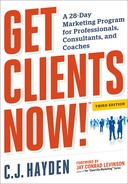Recipe: Distributing Flyers
Printed flyers can be one of the most inexpensive forms of advertising, and an appropriate medium for many professionals marketing to local consumers and small businesses. If you are already doing a fair amount of networking and referral building, you may often find yourself in places where you can hand out, post, or display flyers to increase your visibility and generate new inquiries. Likely flyer venues include the following places:
![]() Networking events. You may be able to hand out flyers when you introduce yourself, leave them on a table for people to pick up, or place one on each chair. If you don’t know what the group’s rules are, be sure to ask first so you don’t offend anyone.
Networking events. You may be able to hand out flyers when you introduce yourself, leave them on a table for people to pick up, or place one on each chair. If you don’t know what the group’s rules are, be sure to ask first so you don’t offend anyone.
![]() Trade shows. If you have a booth, your flyers will be there, of course. If you don’t, you could ask a referral partner to display flyers for you. Many shows prohibit the distribution of flyers by nonexhibitors, but creative marketers have been known to pass out flyers outside the show.
Trade shows. If you have a booth, your flyers will be there, of course. If you don’t, you could ask a referral partner to display flyers for you. Many shows prohibit the distribution of flyers by nonexhibitors, but creative marketers have been known to pass out flyers outside the show.
![]() Educational institutions, association headquarters, health practitioners’ offices, and resource centers. Many organizations and businesses have bulletin boards, resource binders, waiting room counters, or literature racks where your flyers could be seen or picked up.
Educational institutions, association headquarters, health practitioners’ offices, and resource centers. Many organizations and businesses have bulletin boards, resource binders, waiting room counters, or literature racks where your flyers could be seen or picked up.
![]() Community gathering places such as coffee shops, bookstores, libraries, or copy/shipping centers. Bulletin boards and literature racks are common in places like these.
Community gathering places such as coffee shops, bookstores, libraries, or copy/shipping centers. Bulletin boards and literature racks are common in places like these.
The ad copy and layout of your flyer will be important to its effectiveness. Special offers such as “free book or CD of your choice if you schedule before Oct. 31” or “free consultation with this flyer” can encourage people to call. Flyers that advertise only one service at a time typically get more response than those that contain a laundry list of everything you have available.
The most common flyer design is to use a full page and print on one side of colored paper stock. But you could also print your flyer on two sides and fold it into thirds to create the look of a brochure. (A true brochure is typically too costly to use for this sort of distribution.) Or, you could print on card stock and cut your page in half or thirds to create smaller-sized coupons or fact sheets.
The design and printing of your flyer should reflect your level of professionalism. If your flyer looks homemade, that’s how people will view your service. Consider investing a few extra dollars in having your flyer professionally designed. For small quantities, printing flyers on your laser or inkjet printer may be an acceptable solution. For larger numbers, you will want to have your flyers photocopied or printed. Either way, be sure the paper stock and colors you use project the image that you want.
